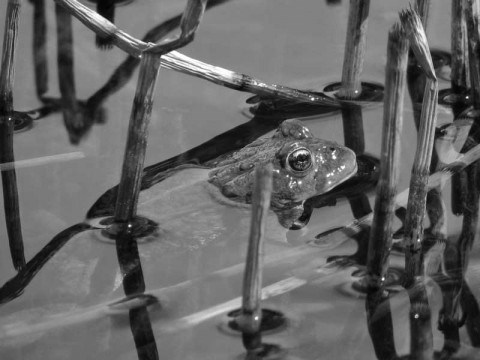There's big news on the toad scene at Lost Lake: we finally found where the adult toads breed. That success led to immediate action by the Resort Municipality of Whistler to protect the breeding area by extending and beefing up the split rail fence.
Here's a little background. Western toads are in decline throughout most of their range, probably due to loss of habitat. What's especially troublesome is that a population can seem fine then all of a sudden disappear. As one of only two known breeding sites in Whistler, Lost Lake is especially important.
Protecting Whistler's toads has been a concern for a long time. Wendy Horan's masters thesis five years ago filled in some blanks. Last year, RMOW Fish and Wildlife Technicians Betty Reballato and Vesna Young teamed up with the Whistler-Blackcomb HIT team to build fencing and a toad bridge.
The goal was to help the metamorphosed tadpoles (toadlets) across the grassy events area and Valley Trail and into the forest beyond.
No one yet knows where the toads overwinter, or really much of anything of them after they leave the lake. Before last month, we didn't even know when and where they bred. Then last week, Kristina Swerhun and I lucked out.
We knew the huge adult toads convene each spring to breed. And we knew their small, black eggs are laid in necklace-like strings, usually in water less than 15 cm deep. Sounds like both adults and eggs would be easy to find, but we didn't know when or where the adult toads convened, and only had a two- to three-day breeding period to locate them. And the eggs, though abundant, camouflage beautifully with the dark vegetation and lake bottom.
Two Saturdays ago, we surveyed the lake edge. We started off the right side of the beach and two hours later hit the jackpot between the main beach and inflow from Blackcomb Creek. We spotted one adult in the water, then a few, and finally tens of them. Probably males, since when contact occurred one would emit a low, duck-like squeak to alert his new, unwanted friend he was also male.
They were there the next day but not the third. On the fourth day, and after many minutes of staring into the shallow water, Kristina made out a couple of eggs, then more and more. Where? About 10 metres from the beach and the sign that proclaims "Wetland at Work."
During our egg survey a dog did what dogs do. It jumped the fence and chased into the water after a mallard. One wayward paw, and those fragile egg strings would be fractured. That's when the RMOW stepped in. Two days later, the split rail fence was extended to the end of the sand and now we hope the toads can continue to do their thing in peace.
May 22 was the United Nations International Day for Biodiversity and 2010 will be the United Nations International Year of Biodiversity. Think about how you can protect and enhance Whistler's native biodiversity.
For photos and video of the toads, or to report your toad sightings, please go to www.whistlerbiodiversity.ca .
Toad Talk
• The "warts" on the Western Toad are not warts at all, but glands that produce a bitter, sticky, white fluid when the toad feels threatened. The fluid can cause an animal's eyes or mouth to tingle or feel numb. This makes Western Toads unpleasant to eat, but will not give you warts.
• Western Toads can identify predators by recognizing the chemical cues they emit. Incredibly, tadpoles injured by predators release chemicals that warn others of impending danger. Some evidence even suggests that chemical cues enable Western Toad tadpoles to recognize their siblings.
• Female Western Toads produce an average of 12,000 eggs, or as many as 16,500 eggs, in a single clutch. More than 99 per cent of these won't survive to adulthood. Those that do may live for several years, as their skin secretions are highly distasteful to would-be predators. In captivity, individuals have survived for up to 36 years.
To KNOW MORE about other actions that are moving our community toward our Whistler2020 Natural Areas Description of Success go to www.whistler2020.ca .




